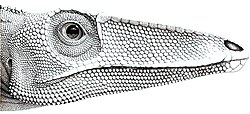
This timeline of coelophysoid research is a chronological listing of events in the history of paleontology focused on the coelophysoids, a group of primitive theropod dinosaurs that were among Earth's dominant predators during the Late Triassic and Early Jurassic epochs. [1] Although formally trained scientists didn't discover coelophysoid fossils until the late 19th century, Native Americans of the modern southwestern United States may have already encountered their fossils. Navajo creation mythology describes the early Earth as being inhabited by a variety of different kinds of monsters who hunted humans for food. These monsters were killed by storms and the heroic Monster Slayers, leaving behind their bones. As these tales were told in New Mexico not far from bonebeds of Coelophysis , this dinosaur's remains may have been among the fossil remains that inspired the story. [2]
Contents
- Prescientific
- 19th century
- 1880s
- 1890s
- 20th century
- 1910s
- 1930s
- 1940s
- 1960s
- 1980s
- 1990s
- 21st century
- 2000s
- 2010s
- See also
- Footnotes
- References
- External links
The first scientifically documented coelophysoid taxon was Coelophysis bauri itself. [3] However, when the species was first described by Edward Drinker Cope in 1887, it was thought to belong to a genus of small carnivorous dinosaurs called Coelurus . [4] Later that same year Cope changed his mind and transferred it to the genus Tanystropheus . Tanystropheus turned out to be a long-necked reptile not regarded by scientists as a true dinosaur. As such, "Tanystrophaeus" bauri was soon given its own genus, Coelophysis in 1889. [5] Over the ensuing decades, many new coelophysoids would be discovered, like Podokesaurus , Procompsognathus , and Segisaurus . [3]
In 1947, a paleontological team led by Edwin Colbert made a major discovery in New Mexico. While on an expedition to Petrified Forest National Park in Arizona, he made a detour to Ghost Ranch, New Mexico where many phytosaur fossils had been found. [6] There they discovered a massive bonebed preserving hundreds of Coelophysis, many of which were complete and articulated. [7] The find has been considered the most significant Triassic fossil discovery in North America. [8] Later, other coelophysoids and even other bonebeds would be discovered. [9] Notable coelophysoids discovered during the mid to late 20th century include Syntarsus (now Megapnosaurus ) and Gojirasaurus . [3] Despite this extensive history of research, the formal recognition of the Coelophysoidea as a distinct group of dinosaurs is relatively recent and the group would not be formally named until a 1994 by Thomas Holtz. [10]








